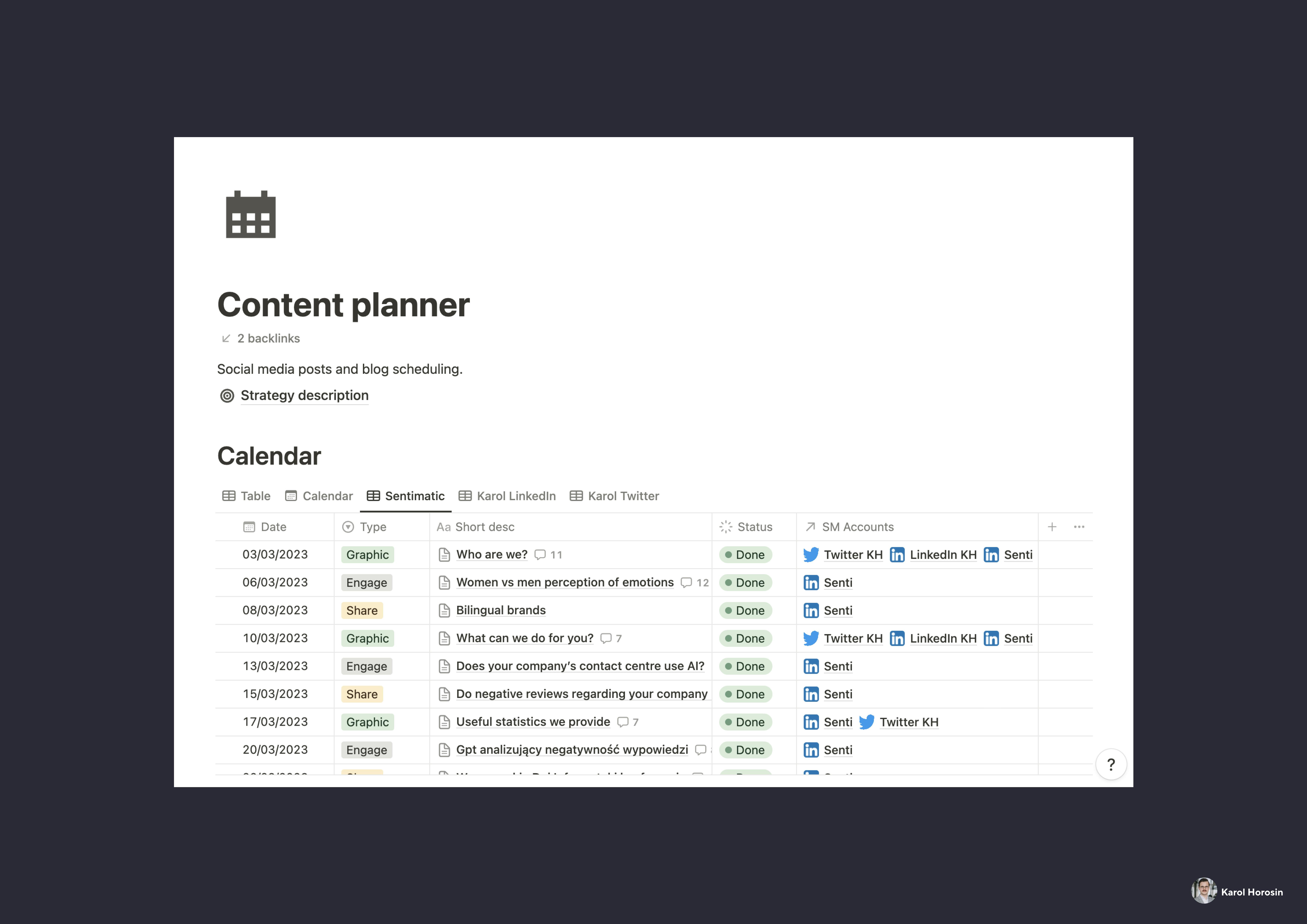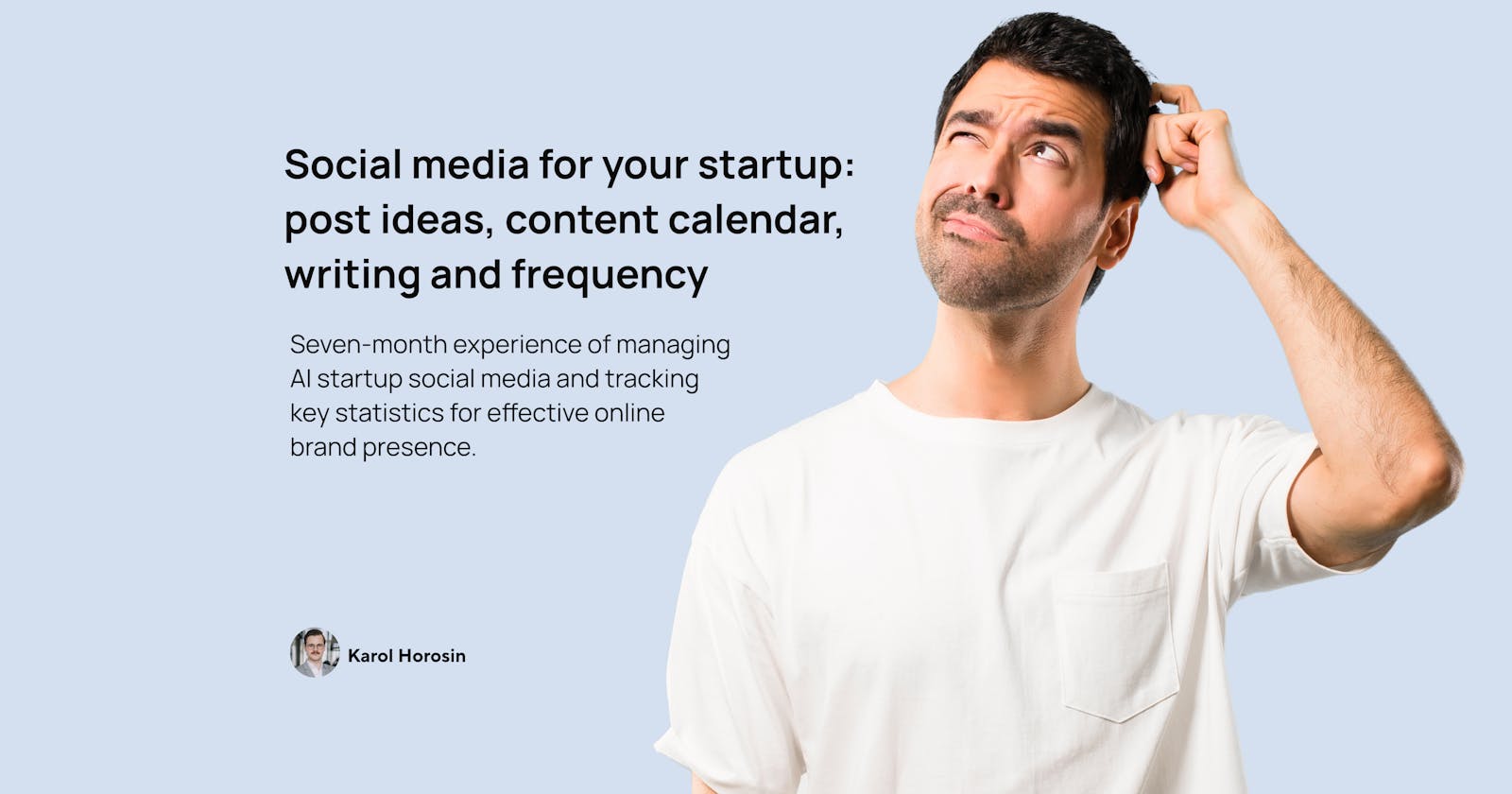Social media for your startup: post ideas, content calendar, writing, frequency
Seven-month experience of managing AI startup social media and tracking key statistics for effective online brand presence.
Seven months ago, I decided to start taking the social media of my AI startup seriously. The goal was to increase online recognition of my product and become more involved in the field of customer service and AI technologies. So far, I have posted nearly 60 times, and although the page doesn't have a massive following, I've learned how to schedule and create content. I've also managed to build a strong showcase of our offerings and refine the language around our features. In this article, I'll guide you through the research I've conducted on social media platforms, scheduling, posting frequency, types of content, generating posts with ChatGPT, expanding the online network, and tracking valuable statistics.
A good organization was essential as the startup takes only a small fraction of my overall work time.
Here's what I've learned so that you don't have to start from scratch:
Platforms
When selecting platforms to post on, I first stated my goals for online presence and based my decisions on them. I came up with four main objectives:
Increasing brand awareness in the Polish market.
Providing accessible brand information for the media.
Collecting sales contacts.
Participating in competitions and accessing funding.
I also checked where other startups active in the AI field promote their brands. It turned out that posts and information are mostly published on LinkedIn and Twitter, less frequently on Facebook, and occasionally on Instagram or YouTube.
Out of all the available social media platforms, I decided to focus on LinkedIn while sharing basic brand information on Twitter and Facebook. Considering the startup is B2B, this seemed to be the most reasonable option.
Frequency
Before deciding on the frequency of my posts, I researched effective posting strategies. The information I found suggested posting content even twice a day, which was an impossible standard for me to meet. I also learned that publishing just once a week can significantly increase a brand's online presence, making this approach more doable. I also researched my competitors to understand how often they post and what types of content they share.
At first, I aimed to post three times a week, but after a few months, I realized this frequency was too excessive for a startup of that size. Posting that often was time-consuming, and I didn't have enough content to produce such a number of posts weekly. I wanted to offer valuable information rather than mostly reposts for the sake of publishing, so I reduced the frequency to one post per week.
Type of content
There are numerous types of posts you can create: text posts, images, infographics, videos, article links, polls, surveys, and more.
From all the available content types, I've chosen three formats that align with my brand's vision: custom graphic publications, shared content (such as article links or podcasts), and user-engaging content (like polls, open-ended questions, or thought-provoking short essays).
So far, I've noticed that self-designed infographics and images, including personal stories (such as team introduction posts or impressions from conferences), gather the most interest. Posting polls when you have a small number of followers can lead to disappointing results. Shared articles can be successful, especially when they cover trending topics or include engaging graphics.

Scheduling
My primary tool for scheduling posts is Notion. I've created a content planner that includes publication dates, content types, post text, and additional graphics to help me maintain an overview of past and future materials. Each item has its status, ranging from not started to in progress, ready to post, and done. I treat posts as tiny projects with clear goals and deadlines.

LinkedIn and Twitter now offer the option to schedule posts in advance. However, once you plan them on LinkedIn, it's not possible to make further changes, which I find unfortunate. I try to schedule my planned posts at the beginning of each week to avoid being occupied with them later.
I try to have publications ready for the two weeks ahead, to have flexibility in case of emergencies or holiday plans. This doesn't mean I don't allow spontaneity - if an interesting AI-related article appears or I come across a valuable post worth sharing on the startup's website, I move the previously planned content a few days forward.
At times I post similar content on my personal accounts, as indicated in the content planner snapshot.
How to write authentic posts? (with some help from ChatGPT)
Based on my experience, a good LinkedIn post should include a catchy and to-the-point headline. This not only introduces the publication's topic but also grabs readers' attention as they scroll through their feeds.
The content you share should be relevant and as personal as possible. Readers appreciate valuable tips and tend to enjoy real-life anecdotes. I always include useful information for my readers that they can implement in their businesses or daily work, regardless of the publication's topic.
Visuals, such as videos, images, or diagrams, make posts more engaging. According to LinkedIn statistics, publications including graphics receive much higher engagement. Whenever I have an opportunity, I create my own diagrams or graphics in Figma. I've noticed that less generic images receive more engagement.
Remember to include relevant hashtags throughout or at the end of the post. Always tag relevant connections. When sharing an article or podcast, I mention its author or presenter, and when sharing event content, I tag organizers and key participants. These simple adjustments increase your brand's visibility and integration into the online community.
According to LinkedIn statistics, the optimal post length is between 100-150 words. I find it challenging to limit my posts to this word count, so they are typically more lengthy. If space is still insufficient, I post additional information in the comments, such as links to articles. To make the reading easier and more pleasing, I use bullet points, short sentences, and emojis.
When writing, ask yourself - is this useful? Am I providing any value to the reader? No one wants to read you bragging or begging for attention.
When creating posts, you can use ChatGPT as your writing assistant. I find it particularly useful when sharing articles. First, I paste the article's content into ChatGPT and request a summary. Then I ask it to create a LinkedIn post based on the summary. I emphasize that I want the post to be personal, written in simple language, with an informative rather than overexcited tone, and including hashtags and emojis. I've noticed that providing detailed instructions helps me receive the most authentic publication ideas. Afterwards, I adapt the provided suggestion to make it more humanlike and personal, tag people I want to mention and conclude the post with a question to engage readers. The final product is filled with startup-specific insights and usually differs a lot from initial AI suggestions.
Which statistics to follow?
To monitor the development of my brand's online presence, I decided to focus on key statistics available in LinkedIn analytics for the company's page. Among all the available data, I concentrate on content engagement and categories of visitors. Tracking post impressions helps me understand what content is the most engaging while analyzing the groups of people visiting my profile allows me to target the potential users that align with my marketing goals.
To keep myself motivated and have a clear vision of my actions I’ve created a Google Sheets file including certain goals regarding my startup’s social media. The table consists of followers' number information on different platforms and the wanted future outcome with a set deadline. I fill in the data weekly and observe if the growth trend fits my expectations. If it doesn’t I try to act on the spot and make adjustments to the planned content or assumed strategies.
I feel like I can do a better job with determining perfect posting times and being more data-driven, but at the same time at this engagement volume, the statistics would be inconclusive.
Conclusions
Summing up, this process has taught me a lot in terms of scheduling, creating, and tracking social media brand content. I plan to continue developing my skills in this area and become a better copywriter. It is crucial to remember your objectives when deciding on the platforms to post on, maintain regularity in your publications, stay organized with both past and future materials, and try to write texts and design images in as authentic a way as possible.
I hope that my brief research has helped you learn the basics of how to develop an online presence for a small company or a product. If you have more questions, please don't hesitate to ask in the comments or DMs. I also look forward to hearing your thoughts on social media content and strategies for promoting your brand online that you've been using so far.
Don't forget to follow me on Twitter @ horosin_ and subscribe to my newsletter for more tips and insights!
If you don't have Twitter, you can also follow me on LinkedIn.
